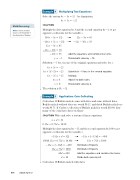Page 429 - Algebra 1
P. 429
Example
4
Multiplying Two Equations
Solve the system 4x - 3y = 15 by elimination. 6x + 5y = -25
SOLUTION
Multiply the first equation by 3 and the second equation by -2 to get opposite coefficients for the variable x.
Math Reasoning
Write Is there another way to solve Example 4 by elimination? Explain.
3(4x - 3y = 15) -2(6x + 5y = -25) 12x - 9y = 45
-12x - 10y = 50 ______ _
-19y = 95 y = -5
12x - 9y = 45 -12x - 10y = 50
Add the equations and combine like terms. Divide both sides by -19.
Substitute -5 for y in one of the original equations and solve for x.
6x + 5y = -25 6x + 5(-5) = -25 6x - 25 = -25
6x = 0 x = 0
Substitute -5 for y in the second equation. Multiply.
Add 25 to both sides.
Divide both sides by 6.
The solution is (0, -5).
Application: Coin Collecting
Carlos has 32 Buffalo nickels, some with dates and some without dates. Buffalo nickels without dates are worth $0.15, and dated Buffalo nickels are worth $0.75. If Carlos’s collection of Buffalo nickels is worth $10.80, how many of the coins have dates on them?
SOLUTION Write and solve a system of linear equations. u + d = 32
0.15u + 0.75d = 10.80
Multiply the first equation by -15 and the second equation by 100 to get opposite coefficients for the variable x.
Example
5
-15(u + d = 32) 100(0.15u + 0.75d = 10.80)
-15u + (-15d) = -480 15u + 75d = 1080
Distributive Property
Distributive Property
Add the equations and combine like terms. Divide both sides by 60.
-15u + (-15d) = -480 15u + 75d = 1080
_____ __ 60d = 600
d = 10
Carlos has 10 Buffalo nickels with dates.
414 Saxon Algebra 1


